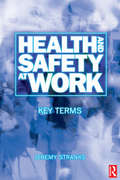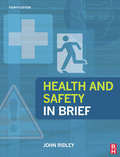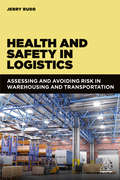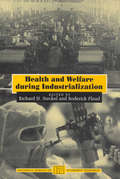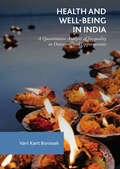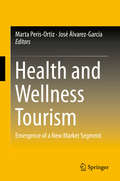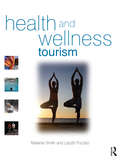- Table View
- List View
Health and Safety: Risk Management
by Tony BoyleHealth and Safety: Risk Management is the clearest and most comprehensive book on risk management available today. This newly revised fifth edition takes into account new developments in legislation, standards and good practice. ISO 45001, the international health and safety management system standard, is given comprehensive treatment, and the latest ISO 9004 and ISO 19011 have also been addressed. The book is divided into four main parts. Part 1.1 begins with a basic introduction to the techniques of health and safety risk management and continues with a description of ISO 45001. Part 1.2 covers basic human factors including how the sense organs work and the psychology of the individual. Part 2.1 deals with more advanced techniques of risk management including advanced incident investigation, audit and risk assessment, and Part 2.2 covers a range of advanced human factors topics including human error and decision making. This authoritative treatment of health and safety risk management is essential reading for both students working towards degrees, diplomas and postgraduate or vocational qualifications, and experienced health and safety professionals, who will find it invaluable as a reference.
Health and Safety: Risk Management
by Tony BoyleHealth and Safety: Risk Management is the clearest and most comprehensive book on risk management available today. This newly revised fifth edition takes into account new developments in legislation, standards and good practice. ISO 45001, the international health and safety management system standard, is given comprehensive treatment, and the latest ISO 9004 and ISO 19011 have also been addressed. The book is divided into four main parts. Part 1.1 begins with a basic introduction to the techniques of health and safety risk management and continues with a description of ISO 45001. Part 1.2 covers basic human factors including how the sense organs work and the psychology of the individual. Part 2.1 deals with more advanced techniques of risk management including advanced incident investigation, audit and risk assessment, and Part 2.2 covers a range of advanced human factors topics including human error and decision making. This authoritative treatment of health and safety risk management is essential reading for both students working towards degrees, diplomas and postgraduate or vocational qualifications, and experienced health and safety professionals, who will find it invaluable as a reference.
Health and Safety at Work: An Essential Guide for Managers (Kogan Page Ser.)
by Jeremy StranksThis practical guide for employers in the UK continues to provide managers with the essential advice on how to establish health and safety procedures in organizations. Written in jargon-free language, Health and Safety at Work cuts through the legal complexities to enable you to fully understand the law and its implications for your business. Filled with expert knowledge and written in an accessible style, this book equips you with the legal and practical knowledge you need to protect your employees and your business. This 10th Edition of the indispensable guide, Health and Safety at Work, has been updated to comply with all recent changes and additions to Health and Safety law including The Reporting of Injuries, Diseases and Dangerous Occurrences Regulations 2013, The Construction (Design and Management) Regulations 2015 and increased legislation and prioritisation of issues of stress at work. This new edition also comes with downloadable online resources and templates that you can use in your business.
Health and Safety at Work: An Essential Guide for Managers
by Jeremy StranksThis practical guide for employers in the UK continues to provide managers with the essential advice on how to establish health and safety procedures in organizations. Written in jargon-free language, Health and Safety at Work cuts through the legal complexities to enable you to fully understand the law and its implications for your business. Filled with expert knowledge and written in an accessible style, this book equips you with the legal and practical knowledge you need to protect your employees and your business. This 10th Edition of the indispensable guide, Health and Safety at Work, has been updated to comply with all recent changes and additions to Health and Safety law including The Reporting of Injuries, Diseases and Dangerous Occurrences Regulations 2013, The Construction (Design and Management) Regulations 2015 and increased legislation and prioritisation of issues of stress at work. This new edition also comes with downloadable online resources and templates that you can use in your business.
Health and Safety at Work: Key Terms
by Jeremy StranksHealth and Safety at Work: Key Terms provides instant information to readers on a range of key terms used in health and safety at work. The book, produced in A-Z format, incorporates the principal legal, technical and practical terms derived from statutes, regulations, approved codes, case law and other appropriate publications. As such, it will be of particular use to health and safety practitioners, those studying for degrees in occupational health and safety and courses run by NEBOSH, and those engaged in enforcement activities, such as Health and Safety Executive inspectors, environmental health officers and fire protection officers.The key terms referenced and explained include: accident statistics; absolute duties; distance guard; noise-induced hearing loss; oxidising classifications; relevant statutory provisions.
Health and Safety at Work For Dummies
by RRCAre you complying with health and safety regulations in the workplace? Making mistakes in many areas of health and safety can be both incredibly dangerous and hugely costly. So what can you do to avoid hazards and expensive, time-consuming legal battles? That's where Health & Safety at Work For Dummies comes in. Cutting through the clutter, it provides you with the practical, must-know information you need to ensure your workplace is a suitably safe environment that complies with government health and safety rules and regulations. Did you know that in 2014, 1.2 million working people suffered from work-related illnesses, 2,535 mesothelioma deaths occurred due to past asbestos exposure and 133 workers were killed on the job? The list goes on – and the statistics are staggering. Health & Safety at Work For Dummies shows you how to keep your employees safe from becoming another statistic in this frightening data. Arming you with critical information needed to adhere to health and safety regulations, it offers expert guidance on managing and implementing health and safety in your business, controlling workplace risks, going the extra mile in following orders and much more. Offers an easy-to-follow overview for getting started with health and safety Provides tips and advice for planning your health and safety management Includes guidance on monitoring and reviewing your health and safety systems Clearly demonstrates how to organize and motivate your workforce to comply with rules and regulations You can't afford to run a business that doesn't provide a safe work environment. Be smart, safe and proactive with the help of this essential guide.
Health and Safety at Work For Dummies
by RRCAre you complying with health and safety regulations in the workplace? Making mistakes in many areas of health and safety can be both incredibly dangerous and hugely costly. So what can you do to avoid hazards and expensive, time-consuming legal battles? That's where Health & Safety at Work For Dummies comes in. Cutting through the clutter, it provides you with the practical, must-know information you need to ensure your workplace is a suitably safe environment that complies with government health and safety rules and regulations. Did you know that in 2014, 1.2 million working people suffered from work-related illnesses, 2,535 mesothelioma deaths occurred due to past asbestos exposure and 133 workers were killed on the job? The list goes on – and the statistics are staggering. Health & Safety at Work For Dummies shows you how to keep your employees safe from becoming another statistic in this frightening data. Arming you with critical information needed to adhere to health and safety regulations, it offers expert guidance on managing and implementing health and safety in your business, controlling workplace risks, going the extra mile in following orders and much more. Offers an easy-to-follow overview for getting started with health and safety Provides tips and advice for planning your health and safety management Includes guidance on monitoring and reviewing your health and safety systems Clearly demonstrates how to organize and motivate your workforce to comply with rules and regulations You can't afford to run a business that doesn't provide a safe work environment. Be smart, safe and proactive with the help of this essential guide.
Health and Safety at Work: Key Terms
by Jeremy StranksHealth and Safety at Work: Key Terms provides instant information to readers on a range of key terms used in health and safety at work. The book, produced in A-Z format, incorporates the principal legal, technical and practical terms derived from statutes, regulations, approved codes, case law and other appropriate publications. As such, it will be of particular use to health and safety practitioners, those studying for degrees in occupational health and safety and courses run by NEBOSH, and those engaged in enforcement activities, such as Health and Safety Executive inspectors, environmental health officers and fire protection officers.The key terms referenced and explained include: accident statistics; absolute duties; distance guard; noise-induced hearing loss; oxidising classifications; relevant statutory provisions.
Health and Safety in Brief (Made Simple Bks.)
by John RidleyIn plain English, John Ridley guides the reader through Health and Safety legislation and explains how to comply with it in practical terms. The text is clearly laid out, distinguishing between bulleted summaries of legislative requirements and the author's advice and commentary.By condensing the fundamental contents of the author's acclaimed Safety at Work into a practical and affordable volume, Health and Safety in Brief has established itself as a valuable handbook for safety representatives and managers, as well as an essential revision aid for students on introductory health & safety and general management courses such as: * NEBOSH National Certificate and Diploma in Occupational Safety and Health* IOSH Managing Safely* CIEH Advanced Certificate in Health & Safety in the Workplace * British Safety Council Level 3 Certificate in Occupational Safety and Health * NVQs in Occupational Safety and Health * Chartered Management Institute's Level 5 Diploma in ManagementNew in this edition:* Completely revised coverage of fire safety in line with Regulatory Reform (Fire Safety) Order* Construction safety incorporates new Construction (Design and Management) Regulations 2007 and new Working at Heights Regulations* Coverage of changes in employment law, including age discrimination and working time* More on the effects of the Woolf Report
Health and Safety in Brief
by John RidleyIn plain English, John Ridley guides the reader through Health and Safety legislation and explains how to comply with it in practical terms. The text is clearly laid out, distinguishing between bulleted summaries of legislative requirements and the author's advice and commentary.By condensing the fundamental contents of the author's acclaimed Safety at Work into a practical and affordable volume, Health and Safety in Brief has established itself as a valuable handbook for safety representatives and managers, as well as an essential revision aid for students on introductory health & safety and general management courses such as: * NEBOSH National Certificate and Diploma in Occupational Safety and Health* IOSH Managing Safely* CIEH Advanced Certificate in Health & Safety in the Workplace * British Safety Council Level 3 Certificate in Occupational Safety and Health * NVQs in Occupational Safety and Health * Chartered Management Institute's Level 5 Diploma in ManagementNew in this edition:* Completely revised coverage of fire safety in line with Regulatory Reform (Fire Safety) Order* Construction safety incorporates new Construction (Design and Management) Regulations 2007 and new Working at Heights Regulations* Coverage of changes in employment law, including age discrimination and working time* More on the effects of the Woolf Report
Health and Safety in Contemporary Britain: Society, Legitimacy, and Change since 1960
by Mike Esbester Paul AlmondThis book analyses the perceived legitimacy of health and safety in post-1960 British public life. Since 2010 health and safety has appeared to be in crisis, being attacked by press, politicians and public alike, but are these claims of crisis accurate? How have understandings of health and safety changed over the past 60 years? By exploring the history, culture, and operation of health and safety in contemporary Britain, this book provides a new assessment of an understudied, but surprisingly far-reaching, part of the British political and social landscape. Combining archival research with focus group, social survey and oral history testimony, the book examines the historical background to health and safety, how health and safety has been enacted in public and in the workplace, the impact of changing economic, occupational and social structures on the operation of health and safety, and the conflicts and interests that have shaped the area.
Health and Safety in Logistics: Assessing and Avoiding Risk in Warehousing and Transportation
by Jerry RuddLogistics is a complex industry that exposes employees to a whole variety of risks. These include not only accidents on the road and deaths and injuries resulting from unsafe use of forklifts, but also the consequences of poor fire safety, long-term health risks due to poor manual handling technique and problems relating to mental health. Many thousands of incidents are recorded every year. This book examines each aspect of health and safety in turn, with a focus on warehousing and transportation.Health and Safety in Logisticsinforms managers about potential hazards found in the industry and explains in detail how they can make the workplace as safe as possible.
Health and Safety in Logistics: Assessing and Avoiding Risk in Warehousing and Transportation
by Jerry RuddLogistics is a complex industry that exposes employees to a whole variety of risks. These include not only accidents on the road and deaths and injuries resulting from unsafe use of forklifts, but also the consequences of poor fire safety, long-term health risks due to poor manual handling technique and problems relating to mental health. Many thousands of incidents are recorded every year. This book examines each aspect of health and safety in turn, with a focus on warehousing and transportation.Health and Safety in Logisticsinforms managers about potential hazards found in the industry and explains in detail how they can make the workplace as safe as possible.
Health and Safety Leadership Strategy: How Authentically Inclusive Leaders Inspire Employees to Achieve Extraordinary Results
by Rosa Antonia CarrilloThe purpose of this book is to awaken leaders to the unique opportunities now present in the areas typically delegated to Health and Safety. It is a strategy to utilize existing resources to fully develop and engage human potential to catapult business achievement. The confluence of Covid-19, the resulting burnout, the attention on diversity, equity and inclusion generated by the Black Lives Matter movement and the ‘great resignation’ continues to create openings to fundamentally change how we address personal development, sustainable growth and social responsibility. The argument within is that the better we manage the social aspects of the organization, the better our business results. Elucidating to the reader the societal shifts of workplace culture in recent years, this text expertly analyzes the importance of mental health in the workplace, whilst also explaining how management and HR departments can improve. It examines who is responsible for generating psychological safety and provides relationship strategies that will improve performance. The critiques in this text establish why it is imperative for business leaders to concentrate on how their company culture affects their employees, and whether their employees feel safe, seen and supported. The concepts and practices in this book are the ones that leaders have used across the ages to create commitment, accountability and excellence. Managers will benefit from a deeper understanding of how these issues impact every aspect of organizational performance. This book is essential reading for executives, leaders and those interested in leadership. They could be in the C-suite, operations, health and safety and HR. It is also directly relevant to organization development and change management specialists interested in including safety within their practice.
Health and Safety Leadership Strategy: How Authentically Inclusive Leaders Inspire Employees to Achieve Extraordinary Results
by Rosa Antonia CarrilloThe purpose of this book is to awaken leaders to the unique opportunities now present in the areas typically delegated to Health and Safety. It is a strategy to utilize existing resources to fully develop and engage human potential to catapult business achievement. The confluence of Covid-19, the resulting burnout, the attention on diversity, equity and inclusion generated by the Black Lives Matter movement and the ‘great resignation’ continues to create openings to fundamentally change how we address personal development, sustainable growth and social responsibility. The argument within is that the better we manage the social aspects of the organization, the better our business results. Elucidating to the reader the societal shifts of workplace culture in recent years, this text expertly analyzes the importance of mental health in the workplace, whilst also explaining how management and HR departments can improve. It examines who is responsible for generating psychological safety and provides relationship strategies that will improve performance. The critiques in this text establish why it is imperative for business leaders to concentrate on how their company culture affects their employees, and whether their employees feel safe, seen and supported. The concepts and practices in this book are the ones that leaders have used across the ages to create commitment, accountability and excellence. Managers will benefit from a deeper understanding of how these issues impact every aspect of organizational performance. This book is essential reading for executives, leaders and those interested in leadership. They could be in the C-suite, operations, health and safety and HR. It is also directly relevant to organization development and change management specialists interested in including safety within their practice.
Health and Safety Management: Principles and Best Practice
by Colin Fuller Luise VassieFor Management and Economic courses with Risk and Strategic Management modules. This book places the theory and practice of occupational health and safety firmly within a strategic business context by making health & safety an equal partner to other strategic business risks. The authors' innovative approach offers a uniquely coherent text in which the essential principles of business risk management are applied to the management of health & safety in order to develop best practice approaches. The authors examine the subject within a global context so are not constrained by local legislation. The first part introduces principles and concepts of risk and the management of risk relevant to a range of organisations and their stakeholders. Crucially and uniquely, it addresses the importance of economic and cost-benefit considerations in risk decision-making. Part Two focuses on best practice techniques in health & safety management drawing on international research. It analyses contributions of training, effective performance measurement, techniques of auditing and benchmarking and the development and measurement of organisational safety cultures. The full text downloaded to your computer With eBooks you can: search for key concepts, words and phrases make highlights and notes as you study share your notes with friends eBooks are downloaded to your computer and accessible either offline through the Bookshelf (available as a free download), available online and also via the iPad and Android apps. Upon purchase, you'll gain instant access to this eBook. Time limit The eBooks products do not have an expiry date. You will continue to access your digital ebook products whilst you have your Bookshelf installed.
Health and Welfare during Industrialization (National Bureau of Economic Research Project Report)
by Richard H. Steckel Roderick FloudIn this unique anthology, Steckel and Floud coordinate ten essays that bring a new perspective to inquiry about standard of living in modern times. These papers are arranged for international comparison, and they individually examine evidence of health and welfare during and after industrialization in eight countries: the United States, Britain, Sweden, the Netherlands, France, Germany, Japan, and Australia. The essays incorporate several indicators of quality of life, especially real per capita income and health, but also real wages, education, and inequality. And while the authors use traditional measures of health such as life expectancy and mortality rates, this volume stands alone in its extensive use of new "anthropometric" data—information about height, weight and body mass index that indicates changes in nations' well-being. Consequently, Health and Welfare during Industrialization signals a new direction in economic history, a broader and more thorough understanding of what constitutes standard of living.
Health and Well-Being in India: A Quantitative Analysis of Inequality in Outcomes and Opportunities
by Vani Kant BorooahThe theme of this book is health outcomes in India, in particular to outcomes relating to its caste and religious groups and, within these groups, to their women and children. The book’s tenor is analytical and based upon a rigorous examination of recent data from both government and non-government sources. The major areas covered are sanitation, use by mothers of the government’s child development services, child malnutrition, deaths in families, gender discrimination, and the measurement of welfare.
Health and Well-Being in India: A Quantitative Analysis of Inequality in Outcomes and Opportunities
by Vani Kant BorooahThe theme of this book is health outcomes in India, in particular to outcomes relating to its caste and religious groups and, within these groups, to their women and children. The book’s tenor is analytical and based upon a rigorous examination of recent data from both government and non-government sources. The major areas covered are sanitation, use by mothers of the government’s child development services, child malnutrition, deaths in families, gender discrimination, and the measurement of welfare.
Health and Wellness Tourism: Emergence of a New Market Segment
by Marta Peris-Ortiz José Álvarez-GarcíaThis book aims to contribute to the literature and aid in developing a theoretical and practical framework in the area of health and wellness tourism. With contributions and research from different countries using a practical approach, this book is an essential source for students, researchers and managers in the health and wellness tourism industry.Recently, there has been an increased interest in health and wellness due to greater life expectancy, aging populations, increasing levels of stress among others. In this context, the concepts of health, wellness, beauty, relaxation, and tourism can be combined to satisfy the needs of people seeking better quality-of-life. This has given rise to health and wellness tourism, a new market segment that contributes to employment and economic growth in the new economy.Health and wellness tourism involves two aspects: therapeutics, which seeks to cure certain diseases; and relaxation and leisure. As an alternative to traditional tourism, health and wellness tourism provides a new means of achieving regional and local development from a demographic, social, environmental and economic point-of-view. It contributes to tourist destinations’ economic growth, acting as a pillar to support other complementary activities. In short, health and wellness tourism contributes to employment growth and regional wealth, contributes to tourism seasonality, promotes quality in tourism destinations, helps create new tourist services with high value, promotes establishment of international cooperation networks, and yields a number of additional benefits. Featuring a variety of programs and initiatives from different regions, with an emphasis on thermal and thalassotherapy establishments, this volume sheds light on this emerging market segment and its implications for economic and policy development.
Health and Wellness Tourism
by Melanie Smith Laszlo PuczkoHealth and Wellness Tourism takes an innovative look at this rapidly growing sector of today’s thriving tourism industry. This book examines the range of motivations that drive this diverse sector of tourists, the products that are being developed to meet their needs and the management implications of these developments.A wide range of international case studies illustrate the multiple aspects of the industry and new and emerging trends including spas, medical wellness, life-coaching, meditation, festivals, pilgrimage and yoga retreats. The authors also evaluate marketing and promotional strategies and assess operational and management issues in the context of health and wellness tourism.This text includes a number of features to reinforce theory for advanced students of hospitality, leisure and tourism and related disciplines.
Health and Wellness Tourism
by Melanie Smith Laszlo PuczkoHealth and Wellness Tourism takes an innovative look at this rapidly growing sector of today’s thriving tourism industry. This book examines the range of motivations that drive this diverse sector of tourists, the products that are being developed to meet their needs and the management implications of these developments.A wide range of international case studies illustrate the multiple aspects of the industry and new and emerging trends including spas, medical wellness, life-coaching, meditation, festivals, pilgrimage and yoga retreats. The authors also evaluate marketing and promotional strategies and assess operational and management issues in the context of health and wellness tourism.This text includes a number of features to reinforce theory for advanced students of hospitality, leisure and tourism and related disciplines.
Health at Older Ages: The Causes and Consequences of Declining Disability Among the Elderly (National Bureau of Economic Research Conference Report)
by David M. Cutler David A. WiseAmericans are living longer—and staying healthier longer—than ever before. Despite the rapid disappearance of pensions and health care benefits for retirees, older people are healthier and better off than they were twenty years ago. In Health at Older Ages, a distinguished team of economists analyzes the foundations of disability decline, quantifies this phenomenon in economic terms, and proposes what might be done to accelerate future improvements in the health of our most elderly populations. This breakthrough volume argues that educational attainment, high socioeconomic status, an older retirement age, and accessible medical care have improved the health and quality of life of seniors. Along the way, it outlines the economic benefits of disability decline, such as an increased rate of seniors in the workplace, relief for the healthcare system and care-giving families, and reduced medical expenses for the elderly themselves. Health at Older Ages will be an essential contribution to the debate about meeting the medical needs of an aging nation.
Health at Older Ages: The Causes and Consequences of Declining Disability Among the Elderly (National Bureau of Economic Research Conference Report)
by David Cutler David A. WiseAmericans are living longer—and staying healthier longer—than ever before. Despite the rapid disappearance of pensions and health care benefits for retirees, older people are healthier and better off than they were twenty years ago. In Health at Older Ages, a distinguished team of economists analyzes the foundations of disability decline, quantifies this phenomenon in economic terms, and proposes what might be done to accelerate future improvements in the health of our most elderly populations. This breakthrough volume argues that educational attainment, high socioeconomic status, an older retirement age, and accessible medical care have improved the health and quality of life of seniors. Along the way, it outlines the economic benefits of disability decline, such as an increased rate of seniors in the workplace, relief for the healthcare system and care-giving families, and reduced medical expenses for the elderly themselves. Health at Older Ages will be an essential contribution to the debate about meeting the medical needs of an aging nation.
Health Care Benchmarking and Performance Evaluation: An Assessment using Data Envelopment Analysis (DEA) (International Series in Operations Research & Management Science #210)
by Yasar A. OzcanThis new edition continues to emphasize the use of data envelopment analysis (DEA) to create optimization-based benchmarks within hospitals, physician group practices, health maintenance organizations, nursing homes and other health care delivery organizations. Suitable for graduate students learning DEA applications in health care as well as for practicing administrators, it is divided into two sections covering methods and applications.Section I considers efficiency evaluations using DEA; returns to scale; weight restricted (multiplier) models; non-oriented or slack-based models, including in this edition two versions of non-controllable variable models and categorical variable models; longitudinal (panel) evaluations and the effectiveness dimension of performance evaluation. A new chapter then looks at new and advanced models of DEA, including super-efficiency, congestion DEA, network DEA, and dynamic network models. Mathematical formulations of various DEA models are placed in end-of-chapter appendices.Section II then looks at health care applications within particular settings, chapter-by-chapter, including hospitals, physician practices, nursing homes and health maintenance organizations (HMOs). Other chapters then explore home health care and home health agencies; dialysis centers, community mental health centers, community-based your services, organ procurement organizations, aging agencies and dental providers; DEA models to evaluate provider performance for specific treatments, including stroke, mechanical ventilation and perioperative services. A new chapter then examines international-country-based applications of DEA in health care in 16 different countries, along with OECD and multi-country studies. Most of the existing chapters in this section were expanded with recent applications.Included with the book is online access to a learning version of DEA Solver software, written by Professor Kaoru Tone, which can solve up to 50 DMUs for various DEA models listed in the User’s Guide at the end of the book.


